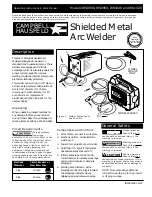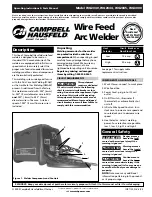
Function description
21
During welding the pulse can be switched off and switched back on by actuating
the torch trigger 2. If torch trigger 2 is actuated during pulsing welding current the
pulses are switched off and welding continues with welding current I
2
. As an
example, this can be used so that the lower welding current I
2
is used until a new
additional material has taken hold and the welding is continued with pulsing
welding current by actuating the torch trigger 2 a second time.
Conventional pulsing: Pulses with pulse times from 0.5 to 5.0 seconds
The setting of the I
1
-pulse time t
1
and the I
2
-pulse time t
2
determines the duration
that current I
1
or current I
2
remains active until switching to the other current. The
actual output welding current is always shown on the indicating instrument.
The times and welding current peaks should be matched so that the base
material is melted during the high current phase and solidified during the low
current phase. In difficult situations (particularly in out of position welding and
large gap bridging) and with thin sheet welding TIG pulse welding enables the
weld pool to be controlled better than with constant welding current.
High frequency puling: with a pulse frequency of 10 Hz to 17.5 Hz.
The flow of the welding current is the same as conventional pulsing. However,
the periods during which current I
1
and I
2
are active are always the same. As this
period is very small a description with pulse frequency is expedient and
customary.
The following correlations apply for the conversion of the pulse frequency for the
each of pulse time t 1 and t 2:
Total pulse time = I
1
-pulse time t
1
+ I
2
-pulse time t
2
= 1 / pulse frequency
I
1
-pulse time t
1
= I
2
-pulse time t
2
= 0.5 * total pulse time
Example:
Pulse frequency = 50 Hz
Total pulse time = I
1
-pulse time t
1
+ I
2
-pulse time t
2
= 1 / Hz = 20 ms = 0.02 s
I
1
-pulse time t
1
= 0.5 * total pulse time
= 0.01s
I
2
-pulse time t
2
= 0.5 * total pulse time
= 0.01s
This means that the current when welding has the value current I
1
for 0.01 s (=
10 ms), then for 0.01 s (= 10 ms) the value current I
2
, then once again for 0.01 s
(= 10 ms) the value current I
1
, etc.
Pulses of such short duration bring about a more narrow arc and deeper
penetration.
The current average value is always shown in the digital indicator instrument
because of the rapid alternations. This means that for welding current I
1
= 100A
and I
2
= 50A the indicator shows 75A.
Summary of Contents for TIGER 180 AC/DC ULTRA
Page 6: ...Introduction 6 1 2 General description Fig 1 TIGER Fig 2 TIGER with integrated Water cooling ...
Page 58: ...Circuit diagram 58 11 Circuit diagrams Circuit diagram TIGER 230 AC DC ...
Page 59: ...Circuit diagram 59 Circuit diagram TIGER 230 AC ...
Page 60: ...Circuit diagram 60 Circuit diagram TIGER 180 AC DC ...
Page 61: ...Circuit diagram 61 Circuit diagram TIGER 180 DC ...
Page 63: ...Circuit diagram 63 Circuit diagram TIGER water cooling unit ...
Page 67: ......















































